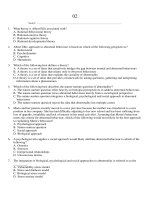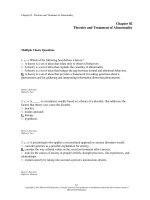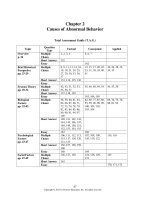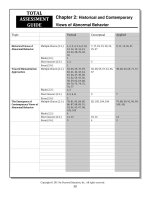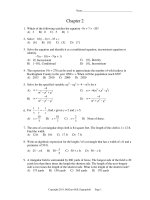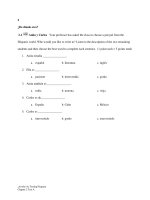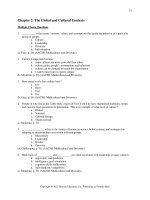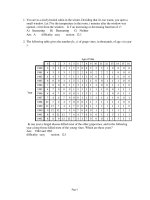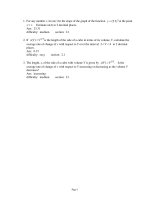Abnormal psychology 6th edition nolen hoeksema test bank
Bạn đang xem bản rút gọn của tài liệu. Xem và tải ngay bản đầy đủ của tài liệu tại đây (246.49 KB, 44 trang )
Chapter 02 - Theories and Treatment of Abnormality
Chapter 02
Theories and Treatment of Abnormality
Multiple Choice Questions
1. (p. 24) Which of the following best defines a theory?
A. A theory is a set of ideas that relate only to observed behaviors.
B. A theory is a set of ideas that explains the causality of abnormality.
C. A theory is a set of ideas that bridges the gap between normal and abnormal behaviors.
D. A theory is a set of ideas that provides a framework for asking questions about a
phenomenon and for gathering and interpreting information about that phenomenon.
Bloom's: Remember
Difficulty: Easy
2. (p. 24) A _____ is a treatment, usually based on a theory of a disorder, that addresses the
factors that theory says cause the disorder.
A. practice
B. modus operandi
C. therapy
D. hypothesis
Bloom's: Remember
Difficulty: Easy
3. (p. 24) A psychologist who applies a sociocultural approach to anxiety disorders would:
A. consider genetics as a possible explanation for anxiety.
B. consider the way cultural values or the social environment affect anxiety.
C. look for the causes of anxiety in people's beliefs, thought processes, life experiences, and
relationships.
D. explain anxiety by taking into account a person's unconscious desires.
Bloom's: Remember
Difficulty: Moderate
2-1
Copyright © 2014 McGraw-Hill Education. All rights reserved. No reproduction or distribution without the prior written consent of
McGraw-Hill Education.
Chapter 02 - Theories and Treatment of Abnormality
4. (p. 24) Maria and her parents recently moved to a new state because her mother received a job
transfer. Maria has had difficulty adjusting to her new school, and has been suffering from
loss of appetite, irritability, and lack of interest in her usual activities. Assuming that Maria's
behavior meets the criteria for abnormal behavior, which of the following would most likely
be the best approach to explaining Maria's behavior?
A. Psychological approach
B. Nature-nurture approach
C. Personal approach
D. Biological approach
Bloom's: Apply
Difficulty: Difficult
5. (p. 24) Which of the following best describes the nature-nurture question of abnormality?
A. The nature-nurture question relies heavily on biological perspectives to address abnormal
behaviors.
B. The nature-nurture question views abnormal behaviors exclusively from a sociological
perspective.
C. The nature-nurture question integrates biological, psychological, and social approaches to
abnormal behaviors.
D. The nature-nurture question rejects the idea that abnormality has multiple causes.
Bloom's: Understand
Difficulty: Moderate
6. (p. 25) Which of the following statements is true about the diathesis-stress model of the
development of disorders?
A. The vulnerability can be biological, psychological, or social, and a stressor causes the
disorder to manifest.
B. An individual experiences a minimal amount of psychological and social stress that creates
an atmosphere for the emergence of a disorder.
C. Biological factors and psychological factors interact and create social stressors that
influence the disorder.
D. Psychological and social vulnerability are loosely associated with the disorder and
biological factors are the main contributors to the disorder.
Bloom's: Understand
Difficulty: Moderate
2-2
Copyright © 2014 McGraw-Hill Education. All rights reserved. No reproduction or distribution without the prior written consent of
McGraw-Hill Education.
Chapter 02 - Theories and Treatment of Abnormality
7. (p. 24) Which of the following statements is true regarding the different approaches to
abnormality and the continuum model?
A. People who favor a sociocultural approach generally embrace the continuum model
because they view psychological disorders as vastly different from normal functioning.
B. People who take a biological approach have traditionally accepted a continuum model of
abnormality.
C. People who adopt a psychological approach have moved away from a continuum model of
psychopathology in recent years.
D. Proponents of the sociocultural approach tend to view abnormal behaviors as
understandable consequences of social stresses in people's lives.
Bloom's: Remember
Difficulty: Moderate
8. (p. 26) The biological approach to abnormality focuses on all of the following causes of
abnormality EXCEPT:
A. brain dysfunction.
B. genetic abnormalities.
C. biochemical imbalance.
D. poor physiological responses.
Bloom's: Remember
Difficulty: Easy
9. (p. 27) Which of the following statements is true about the various structures of the brain?
A. The pons control arousal and attention to stimuli.
B. The medulla is important for attentiveness and the timing of sleep.
C. The cerebellum helps control breathing and reflexes.
D. The superior colliculus and inferior colliculus relay sensory information and control
movement.
Bloom's: Remember
Difficulty: Difficult
2-3
Copyright © 2014 McGraw-Hill Education. All rights reserved. No reproduction or distribution without the prior written consent of
McGraw-Hill Education.
Chapter 02 - Theories and Treatment of Abnormality
10. (p. 27) The outer layer of the cerebrum is called the _____.
A. hippocampus
B. cerebral cortex
C. thalamus
D. limbic system
Bloom's: Remember
Difficulty: Easy
11. (p. 27) The cerebral cortex is responsible for:
A. regulating sexual drive.
B. advanced thinking processes.
C. relaying messages to the brain.
D. impulse control.
Bloom's: Remember
Difficulty: Easy
12. (p. 28) Abnormality that involves eating, drinking, and sexual behaviors are the result of the
dysfunction of the:
A. right frontal lobe.
B. cerebrum.
C. hypothalamus.
D. midbrain.
Bloom's: Remember
Difficulty: Moderate
2-4
Copyright © 2014 McGraw-Hill Education. All rights reserved. No reproduction or distribution without the prior written consent of
McGraw-Hill Education.
Chapter 02 - Theories and Treatment of Abnormality
13. (p. 27) Which of the following statements is true of subcortical structures?
A. The thalamus directs incoming information from sense receptors to the cerebrum.
B. The hypothalamus is a large structure just above the thalamus that regulates instinctive
behaviors.
C. The hippocampus is a part of the limbic system that plays a central role in emotions such as
fear.
D. The amygdala is a structure of the limbic system that plays a role in memory.
Bloom's: Remember
Difficulty: Moderate
14. (p. 28) Cindy's mood has become increasingly unstable since her traffic accident. She often
experiences bouts of aggression and fits of rage in reaction to the slightest provocation. At
other times, she can be overly passive and fails to recognize direct threats. Most likely,
damage has occurred in the _____ of Cindy's brain.
A. temporal lobe
B. limbic system
C. cerebellum
D. medulla
Bloom's: Apply
Difficulty: Difficult
15. (p. 29) Biochemicals that carry impulses from one neuron to another in the brain and in other
parts of the nervous system are called _____.
A. hormones
B. neurotransmitters
C. electrical transmissions
D. synaptic responses
Bloom's: Remember
Difficulty: Easy
2-5
Copyright © 2014 McGraw-Hill Education. All rights reserved. No reproduction or distribution without the prior written consent of
McGraw-Hill Education.
Chapter 02 - Theories and Treatment of Abnormality
16. (p. 29) Neurotransmitters are released into the _____, the gap between synaptic terminals
and adjacent neurons, and then bind to special _____, molecules on the membrane of adjacent
neurons.
A. receptor; dendrites
B. synapse; receptors
C. synapse; axons
D. receptor; cell bodies
Bloom's: Remember
Difficulty: Easy
17. (p. 29) When the initial neuron releasing a neurotransmitter into the synapse reabsorbs some
of the neurotransmitter and thereby decreases the amount of neurotransmitter left in the
synapse, the process is called _____.
A. reuptake
B. degradation
C. blocking
D. carrying
Bloom's: Remember
Difficulty: Easy
18. (p. 29) Degradation refers to the:
A. release of neurons into the synaptic gap.
B. reabsorption of the neurotransmitter into the initial neuron.
C. attachment of the neurotransmitter to a receptor.
D. release of an enzyme by the receiving neuron that breaks down the neurotransmitter into
other biochemicals.
Bloom's: Remember
Difficulty: Easy
2-6
Copyright © 2014 McGraw-Hill Education. All rights reserved. No reproduction or distribution without the prior written consent of
McGraw-Hill Education.
Chapter 02 - Theories and Treatment of Abnormality
19. (p. 30) Which of the following neurotransmitters plays an important role in regulating
emotional well-being and aggressive impulses?
A. Dopamine
B. Norepinephrine
C. Acetylcholine
D. Serotonin
Bloom's: Remember
Difficulty: Easy
20. (p. 30) Dopamine plays an important role in:
A. regulating sexual drive and emotional responses.
B. the functioning of muscle systems.
C. regulating pain and moods.
D. inhibiting aggression.
Bloom's: Remember
Difficulty: Easy
21. (p. 30) When ingested, which of the following substances slows the reuptake process of
norepinephrine?
A. Cocaine and heroin
B. Heroin and marijuana
C. Marijuana and amphetamines
D. Amphetamines and cocaine
Bloom's: Remember
Difficulty: Moderate
2-7
Copyright © 2014 McGraw-Hill Education. All rights reserved. No reproduction or distribution without the prior written consent of
McGraw-Hill Education.
Chapter 02 - Theories and Treatment of Abnormality
22. (p. 30) In the context of emotional responses, gamma-aminobutyric acid (GABA) plays an
important role in _____.
A. anxiety
B. depression
C. anger
D. sadness
Bloom's: Remember
Difficulty: Easy
23. (p. 30) A _____ is a chemical that carries messages throughout the body, potentially
affecting a person's moods, levels of energy, and reactions to stress.
A. hormone
B. degradation inhibitor
C. neuron
D. synapse
Bloom's: Remember
Difficulty: Easy
24. (p. 30) The "master" gland is also known as the _____.
A. islets of Langerhans
B. Organ of Corti
C. adrenal gland
D. pituitary gland
Bloom's: Remember
Difficulty: Easy
25. (p. 30) The pituitary gland is responsible for:
A. stabilizing mood and emotions.
B. controlling brain function and relaying messages.
C. regulating energy levels and managing aggression.
D. producing a variety of hormones and controlling the secretion of other endocrine glands.
Bloom's: Remember
Difficulty: Moderate
2-8
Copyright © 2014 McGraw-Hill Education. All rights reserved. No reproduction or distribution without the prior written consent of
McGraw-Hill Education.
Chapter 02 - Theories and Treatment of Abnormality
26. (p. 31) When corticotrophin-release factor (CRF) travels from the hypothalamus to the
pituitary, the pituitary releases the body's adrenocorticotropic hormone (ACTH). The
bloodstream carries ACTH to the adrenal gland and various other organs. This example
illustrates the complex relationship between:
A. the pituitary gland and hormones.
B. hormones and the endocrine system.
C. the endocrine system and the pituitary gland.
D. the central nervous system and the endocrine system.
Bloom's: Understand
Difficulty: Moderate
27. (p. 31) Mark has difficulty managing his stress. His physician suspects that he has a
dysregulated hypothalamic-pituitary-adrenal (HPA) axis. It is likely that Mark may later be
diagnosed with a(n):
A. personality disorder.
B. depressive disorder.
C. adjustment disorder.
D. impulse control disorder.
Bloom's: Apply
Difficulty: Moderate
28. (p. 31) Which of the following is correct regarding chromosomes?
A. At conception, the fertilized embryo has 48 chromosomes, 24 from the female egg and 24
from the male sperm.
B. The mother of an embryo always contributes a Y chromosome and the father always
contributes an X chromosome.
C. Down syndrome results when chromosome 21 is present in triplicate.
D. Chromosomes have no relationship to deoxyribonucleic acid (DNA).
Bloom's: Understand
Difficulty: Moderate
2-9
Copyright © 2014 McGraw-Hill Education. All rights reserved. No reproduction or distribution without the prior written consent of
McGraw-Hill Education.
Chapter 02 - Theories and Treatment of Abnormality
29. (p. 31) Sandy was born with a small nose, protruding lips and tongue, and chromosome 21
was present in triplicate. Sandy was most likely born with _____.
A. Klinefelter syndrome
B. Down syndrome
C. Tay-Sachs disease
D. Fragile X syndrome
Bloom's: Apply
Difficulty: Moderate
30. (p. 31-32) Which of the following is NOT true about behavior genetics?
A. Behavior genetics is the study of the genetics of personality and abnormality.
B. Research in behavior genetics focuses primarily on twin studies.
C. Most disorders result from polygenic processes according to behavior genetics.
D. Behavior geneticists investigate the heritability of behaviors and behavioral tendencies.
Bloom's: Understand
Difficulty: Moderate
31. (p. 32) A polygenic process:
A. refers to the multiple abnormal genes that interact to create a disorder.
B. results from the interaction between hormones and neurotransmitters.
C. creates the coded instructions for cells to perform certain functions.
D. controls the basic genetic transmission that occurs during conception.
Bloom's: Remember
Difficulty: Moderate
32. (p. 32) Identical twins have _____ of their genes in common.
A. 25 percent
B. 50 percent
C. 75 percent
D. 100 percent
Bloom's: Remember
Difficulty: Easy
2-10
Copyright © 2014 McGraw-Hill Education. All rights reserved. No reproduction or distribution without the prior written consent of
McGraw-Hill Education.
Chapter 02 - Theories and Treatment of Abnormality
33. (p. 32-33) Which of the following is NOT true about the interactions between genes and the
environment?
A. Genetic factors can influence the kinds of environments we choose.
B. The environment can act as a catalyst for a genetic tendency.
C. Environmental conditions can affect the expression of genes.
D. Personalities and interests are not reinforced by the environments we choose.
Bloom's: Remember
Difficulty: Easy
34. (p. 33) _____ is the study of heritable changes in the expression of genes without change in
the gene sequence.
A. Molecular biology
B. Genetic engineering
C. Epigenetics
D. Molecular cloning
Bloom's: Remember
Difficulty: Easy
35. (p. 33) The research on epigenetic processes carried out by Michael Meany found that:
A. the behavior of mother rats toward their offspring influences the development of the pups'
reactions to stress in adulthood.
B. the extent to which the mother rat grooms the pup in the first week of life is indirectly
related to the release of certain hormones in the pup.
C. pups that are licked and groomed more tend to grow into adult rats that are more fearful
and show less developed responses to stress.
D. the biological offspring of mothers who typically lick and groom less, when raised by
mothers who lick and groom more, have less effective stress responses.
Bloom's: Remember
Difficulty: Moderate
2-11
Copyright © 2014 McGraw-Hill Education. All rights reserved. No reproduction or distribution without the prior written consent of
McGraw-Hill Education.
Chapter 02 - Theories and Treatment of Abnormality
36. (p. 33-34) Which of the following statements is true about different drug therapies?
A. Phenothiazines, also known as atypical antipsychotics, are used to reduce hallucinations
and delusions, and do not induce dangerous side effects.
B. Selective serotonin reuptake inhibitors (SSRIs) are the most frequently used
antidepressants which target both serotonin and norepinephrine.
C. Tricyclic antidepressants and the monoamine oxidase inhibitors are the newer classes of
antidepressants.
D. SSRIs and SNRIs produce common side effects such as nausea, diarrhea, headaches,
daytime sedation, sexual dysfunction, and agitation.
Bloom's: Remember
Difficulty: Moderate
37. (p. 34) Lithium is:
A. a rare metallic element found only in natural springs.
B. a safer treatment than anticonvulsants because it has fewer and milder side effects.
C. commonly used in the treatment of bipolar disorder.
D. very effective in reducing tardive dyskinesia.
Bloom's: Remember
Difficulty: Moderate
38. (p. 34) A major class of anxiety-reducing drugs, _____, appears to reduce the symptoms of
anxiety without interfering substantially with an individual's ability to function in daily life.
Their most frequent use is as sleeping pills.
A. barbiturates
B. benzodiazepines
C. azapirones
D. beta-blockers
Bloom's: Remember
Difficulty: Easy
2-12
Copyright © 2014 McGraw-Hill Education. All rights reserved. No reproduction or distribution without the prior written consent of
McGraw-Hill Education.
Chapter 02 - Theories and Treatment of Abnormality
39. (p. 35) Electroconvulsive therapy was originally designed to treat which mental disorder?
A. Obsessive-compulsive disorder
B. Panic disorder without agoraphobia
C. Generalized anxiety disorder
D. Schizophrenia
Bloom's: Remember
Difficulty: Easy
40. (p. 35) Which of the following statements is true of electroconvulsive therapy (ECT)?
A. A current of 70 to 150 volts is passed through the brain for five seconds.
B. Patients are conscious when the brain seizure is induced.
C. Patients typically have a convulsion, which usually lasts 3 minutes or more.
D. The side effects of ECT involve confusion and memory loss.
Bloom's: Remember
Difficulty: Easy
41. (p. 38) When treating a patient with electroconvulsive therapy (ECT), approximately how
many sessions are necessary?
A. 4 to 6 sessions
B. 5 to 7 sessions
C. 6 to 8 sessions
D. 6 to 12 sessions
Bloom's: Remember
Difficulty: Easy
2-13
Copyright © 2014 McGraw-Hill Education. All rights reserved. No reproduction or distribution without the prior written consent of
McGraw-Hill Education.
Chapter 02 - Theories and Treatment of Abnormality
42. (p. 35) A procedure known as _____ exposes patients to frequent, high-intensity magnetic
pulses that are focused on particular brain structures, whereas in the _____ procedure,
electrodes are surgically implanted in specific areas of the brain.
A. repetitive transcranial magnetic stimulation; deep brain stimulation
B. deep brain stimulation; vagus nerve stimulation
C. vagus nerve stimulation; repetitive transcranial magnetic stimulation
D. deep brain stimulation; repetitive transcranial magnetic stimulation
Bloom's: Remember
Difficulty: Moderate
43. (p. 35) The procedure introduced by neurologist Antonio de Egas Moniz in 1935 in which
the frontal lobes of the brain are severed from the lower centers of the brain is called:
A. partial lobectomy.
B. prefrontal lobotomy.
C. vagus nerve stimulation.
D. craniectomy.
Bloom's: Remember
Difficulty: Easy
44. (p. 35) Today, psychosurgery:
A. is outlawed in the United States.
B. is only used for severe disorders that do not respond to other treatments.
C. is no longer controversial, as it formerly was.
D. is found to generally lack precision.
Bloom's: Remember
Difficulty: Easy
2-14
Copyright © 2014 McGraw-Hill Education. All rights reserved. No reproduction or distribution without the prior written consent of
McGraw-Hill Education.
Chapter 02 - Theories and Treatment of Abnormality
45. (p. 36) Which of the following is a criticism leveled against the biological approach to
abnormality?
A. It often ignores the fact that environmental and psychological processes can affect
biological functioning.
B. It argues that people prefer to deal with the issues in their lives that are contributing to their
psychological problems rather than turn to drugs.
C. It seems to erase any blame or responsibility that might be put upon the sufferer of a
disorder.
D. It forces people who suffer disorders to simply accept that they have a disease and obtain
the appropriate treatment.
Bloom's: Remember
Difficulty: Moderate
46. (p. 36) Behavioral theorists:
A. accept the idea that unconscious conflicts drive human behavior.
B. include biological factors as contributing to abnormal behaviors.
C. view maladaptive thinking patterns as the primary motivators for abnormal behaviors.
D. focus on the influence of reinforcement and punishment in producing behavior.
Bloom's: Remember
Difficulty: Easy
47. (p. 36) What are the core principles of the behavioral approach?
A. Classical reinforcement and operant conditioning
B. Operant punishment and vicarious reinforcement
C. Classical conditioning and operant conditioning
D. Operant conditioning and latent learning
Bloom's: Remember
Difficulty: Easy
2-15
Copyright © 2014 McGraw-Hill Education. All rights reserved. No reproduction or distribution without the prior written consent of
McGraw-Hill Education.
Chapter 02 - Theories and Treatment of Abnormality
48. (p. 36) The Russian physiologist whose discovery of conditioned responses made a
tremendous impact on psychology was _____.
A. B. F. Skinner
B. John Watson
C. Edward Thorndike
D. Ivan Pavlov
Bloom's: Remember
Difficulty: Easy
49. (p. 36) In Pavlov's experiment, the conditioned stimulus was:
A. the event that elicited the unlearned response.
B. the previously neutral stimulus.
C. a reinforcement that elicited the learned response.
D. the same as the unconditioned stimulus.
Bloom's: Understand
Difficulty: Moderate
50. (p. 36) Alexis was a sick child who made frequent visits to the hospital to get her shots. One
day she and her mother drove past the hospital, and Alexis began to cry. She repeatedly said,
"Mommy, I don't want to see the doctor." In this example, the conditioned stimulus would be
_____.
A. the parking lot
B. the shot
C. the nurse
D. the hospital
Bloom's: Apply
Difficulty: Difficult
2-16
Copyright © 2014 McGraw-Hill Education. All rights reserved. No reproduction or distribution without the prior written consent of
McGraw-Hill Education.
Chapter 02 - Theories and Treatment of Abnormality
51. (p. 36) A bee stung Leah while she was playing in the yard a few weeks ago. She now
becomes panicky each time she goes out to play. In this example, the conditioned stimulus is
_____.
A. the sting
B. playing outside
C. seeing the bee
D. feeling panicky
Bloom's: Apply
Difficulty: Difficult
52. (p. 36-37) The law of effect suggests that:
A. the strength of the reward has no bearing on behaviors.
B. punishment has no impact on undesired behaviors.
C. behaviors followed by a reward are strengthened.
D. punishments are more effective than rewards.
Bloom's: Remember
Difficulty: Moderate
53. (p. 37) Shaping behaviors by providing rewards for desired responses and punishments for
undesired responses is known as _____.
A. classical conditioning
B. operant conditioning
C. respondent conditioning
D. avoidant conditioning
Bloom's: Remember
Difficulty: Easy
2-17
Copyright © 2014 McGraw-Hill Education. All rights reserved. No reproduction or distribution without the prior written consent of
McGraw-Hill Education.
Chapter 02 - Theories and Treatment of Abnormality
54. (p. 37) Which of the following is NOT an example of a behavior learned through operant
conditioning?
A. An adolescent washing the car hoping to get a curfew extension.
B. A person jumping back at the sight of a snake.
C. A prison inmate receiving tokens for good behavior.
D. An animal staying still to avoid an electric shock.
Bloom's: Apply
Difficulty: Moderate
55. (p. 37) Tracy always seemed to "forget" to do her weekly chores, despite many reminders by
her mom and dad. Her parents decided to pay her $2 for each chore she completed by Sunday
night each week. Which type of schedule did Tracy's parents put her on?
A. Continuous reinforcement schedule
B. Partial reinforcement schedule
C. Continuous punishment schedule
D. Partial punishment schedule
Bloom's: Apply
Difficulty: Moderate
56. (p. 37) When a learned behavior is eliminated, the process is called _____.
A. removal
B. extinction
C. disappearance
D. vanishing
Bloom's: Remember
Difficulty: Easy
2-18
Copyright © 2014 McGraw-Hill Education. All rights reserved. No reproduction or distribution without the prior written consent of
McGraw-Hill Education.
Chapter 02 - Theories and Treatment of Abnormality
57. (p. 37) If a behavior is _____ reinforced, it is more difficult to extinguish.
A. negatively
B. partially
C. continuously
D. positively
Bloom's: Remember
Difficulty: Moderate
58. (p. 37) Jessica had a car accident while crossing an icy bridge. She now maps out her routes
to avoid traveling over bridges. This avoidance helps to reduce her anxiety. In this example,
Jessica has developed a(n) _____.
A. unconditioned response
B. conditioned avoidance response
C. continuous reinforcement schedule
D. unconditioned avoidance response
Bloom's: Apply
Difficulty: Moderate
59. (p. 38) Social learning theory posits that:
A. people learn behaviors by watching other people.
B. people learn as a direct result of rewards and punishments.
C. learning primarily occurs by observing random people.
D. learning occurs when two stimuli are paired together.
Bloom's: Remember
Difficulty: Easy
2-19
Copyright © 2014 McGraw-Hill Education. All rights reserved. No reproduction or distribution without the prior written consent of
McGraw-Hill Education.
Chapter 02 - Theories and Treatment of Abnormality
60. (p. 38) Joe's favorite food is spaghetti. His mom always makes it for him on Friday night,
but she does not like the way he slurps the spaghetti into his mouth. One Friday night, she
attempted to change Joe's eating pattern. At dinner, she picked up her spoon and fork and
began to roll the spaghetti. David, Joe's brother, used his fork and spoon as well. Susan, Joe's
sister, also used her fork and spoon to roll her spaghetti. At first, Joe slurped the spaghetti into
his mouth, but after a few minutes, he began to use his fork and spoon. In this example, Joe is
_____.
A. shaping behaviors
B. modeling behaviors
C. reinforcing behaviors
D. acquiring behaviors
Bloom's: Apply
Difficulty: Easy
61. (p. 38) Jerry, who can't sit still for a minute, sees his classmate, Mike, getting a sticker for
sitting quietly in his seat. Jerry decides to stop fidgeting and begins to sit still in the hope of
getting as sticker for his sticker collection. Which behavioral theory is in effect here?
A. Classical conditioning
B. Observational learning
C. Systematic desensitization therapy
D. Causal attribution
Bloom's: Apply
Difficulty: Easy
62. (p. 38) When Kathryn was visiting her grandmother one summer, a snake crawled on the
front porch. Since then, Kathryn has been dreadfully afraid of snakes. Which technique would
a behavioral therapist most likely use in this situation?
A. Modeling
B. Systematic desensitization
C. Operant conditioning
D. Reinforcement
Bloom's: Apply
Difficulty: Moderate
2-20
Copyright © 2014 McGraw-Hill Education. All rights reserved. No reproduction or distribution without the prior written consent of
McGraw-Hill Education.
Chapter 02 - Theories and Treatment of Abnormality
63. (p. 38-39) Which of the following statements is true about systematic desensitization
therapy?
A. It requires the client to first develop a hierarchy of feared stimuli and then learn
appropriate responses to each of these stimuli, starting with the most feared stimulus.
B. It is an immediate and direct method for extinguishing anxiety responses to stimuli and
maladaptive behavior.
C. It generally produces better results when the client is asked to experience the stimuli
directly, that is, using the in vivo exposure method.
D. It is often combined with operant conditioning to develop a conditioned avoidance
response.
Bloom's: Remember
Difficulty: Moderate
64. (p. 39) All of the following are limitations of behavioral theories EXCEPT that:
A. it is unclear how behavioral principles could account for some disorders, such as
schizophrenia.
B. the development of normal and abnormal behaviors has been scientifically tested by
behavioral theory hypotheses.
C. the complexity of human behaviors and the environmental experiences cannot be captured
in laboratory studies.
D. behavioral theories do not recognize free will in people's behavior.
Bloom's: Remember
Difficulty: Moderate
65. (p. 39) Cognitive theories focus on _____.
A. measurable behaviors
B. thoughts and beliefs
C. unconscious conflicts
D. relationships
Bloom's: Remember
Difficulty: Easy
2-21
Copyright © 2014 McGraw-Hill Education. All rights reserved. No reproduction or distribution without the prior written consent of
McGraw-Hill Education.
Chapter 02 - Theories and Treatment of Abnormality
66. (p. 39) Martha was distraught when she discovered her husband had been involved with
another woman and the relationship produced a child. She constantly tries to understand why
her husband cheated on her, thinking thoughts such as "I'm so stupid for not realizing what
was going on," and, "I should have been more attentive to his needs." Which type of cognition
is Martha most likely exhibiting?
A. Degradation
B. Causal attributions
C. Global assumptions
D. Catharsis
Bloom's: Apply
Difficulty: Moderate
67. (p. 40) The broad beliefs we have about ourselves, our relationships, and the world, can be
either positive and helpful to us, or negative and destructive. These broad beliefs are called
_____.
A. global assumptions
B. universal assumptions
C. absolute assumptions
D. collective assumptions
Bloom's: Remember
Difficulty: Easy
68. (p. 40) Jamie is constantly saying, "I have no control over my emotions, and cannot help
feeling certain feelings." This is an example of _____.
A. causal attributions
B. dysfunctional global assumptions
C. systematic desensitization
D. cognitive-behavioral therapy
Bloom's: Apply
Difficulty: Moderate
2-22
Copyright © 2014 McGraw-Hill Education. All rights reserved. No reproduction or distribution without the prior written consent of
McGraw-Hill Education.
Chapter 02 - Theories and Treatment of Abnormality
69. (p. 40) People who tend to hold dysfunctional assumptions often react to situations with all
of the following EXCEPT:
A. irrational thoughts.
B. rational behaviors.
C. negative emotions.
D. irrational behaviors.
Bloom's: Remember
Difficulty: Easy
70. (p. 40) Which of the following is NOT a goal of cognitive therapy?
A. Assist clients in identifying their irrational and maladaptive thoughts.
B. Teach clients to consider alternative ways of thinking.
C. Discourage clients from challenging their irrational or maladaptive thoughts.
D. Encourage clients to face their worst fears and recognize ways of coping.
Bloom's: Remember
Difficulty: Easy
71. (p. 40) Cognitive techniques are often combined with behavioral techniques, in what is
known as _____.
A. cognitive-behavioral therapy.
B. systematic desensitization therapy.
C. psychotherapy.
D. client-centered therapy.
Bloom's: Remember
Difficulty: Easy
2-23
Copyright © 2014 McGraw-Hill Education. All rights reserved. No reproduction or distribution without the prior written consent of
McGraw-Hill Education.
Chapter 02 - Theories and Treatment of Abnormality
72. (p. 41) Which of the following is the greatest limitation of the cognitive theories?
A. Cognitive theories may seem comfortable or familiar to laypersons.
B. Cognitive theories seem attractive because they focus on an individual's thinking
processes.
C. Cognitive theories are least likely to explain unwanted emotions, thoughts, and behaviors.
D. Cognitive theories have had difficulty proving that maladaptive cognitions precede and
cause disorders rather than being the symptoms or consequences of the disorders.
Bloom's: Remember
Difficulty: Moderate
73. (p. 41) The psychodynamic perspective views abnormality as being influenced by:
A. unconscious processes.
B. an external locus of control.
C. learning and reinforcement.
D. collective experience.
Bloom's: Remember
Difficulty: Easy
74. (p. 41) The psychoanalytic approach to personality and treatment of psychopathology was
developed by _____.
A. Horney
B. Breuer
C. Charcot
D. Freud
Bloom's: Remember
Difficulty: Easy
2-24
Copyright © 2014 McGraw-Hill Education. All rights reserved. No reproduction or distribution without the prior written consent of
McGraw-Hill Education.
Chapter 02 - Theories and Treatment of Abnormality
75. (p. 41) Repression is defined as:
A. inconsistent memories.
B. false memories.
C. motivated forgetting.
D. personal forgetfulness.
Bloom's: Remember
Difficulty: Moderate
76. (p. 41) Freud believed that _____ is a basic drive that motivates human behavior.
A. libido
B. the subconscious
C. catharsis
D. repression
Bloom's: Remember
Difficulty: Easy
77. (p. 42) The three systems of the human psyche that regulate the libido are the:
A. personal unconscious, collective unconscious, and archetypes.
B. id, ego, and superego.
C. ego, unconscious, and subconscious.
D. aggressive drive, id, and the superego.
Bloom's: Remember
Difficulty: Easy
78. (p. 42) The id operates by the:
A. reality principle.
B. morality principle.
C. conscience principle.
D. pleasure principle.
Bloom's: Remember
Difficulty: Easy
2-25
Copyright © 2014 McGraw-Hill Education. All rights reserved. No reproduction or distribution without the prior written consent of
McGraw-Hill Education.
